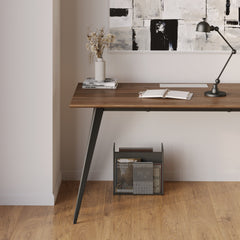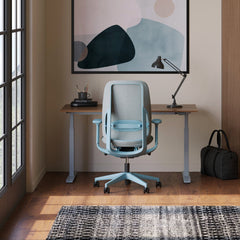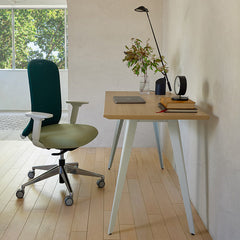Get 10% off your first order
Find the office furniture that’s designed to match your style, comfort, and needs perfectly. Subscribe
Spaces That Shift With You: Building a Workspace That Adapts to Every Task

Visit quiz page to see how we makes it easy to create an inspiring workplace

Remote and hybrid work have permanently reshaped how people use space at home. A kitchen nook, a unused corner, or a compact spare room can now function as a daily workstation. Comfort and posture support determine whether those spaces help you focus or lead to fatigue. Affordable office chairs have evolved dramatically, offering thoughtful ergonomics, breathable materials, and compact frames that suit both apartments and larger homes. The goal is simple: choose a chair that fits your body, aligns with your desk, and helps you stay comfortable and productive throughout the day.
Sustained sitting changes how the body distributes weight through the spine, hips, and shoulders. Without proper lumbar alignment, the pelvis tilts, and the neck compensates, creating discomfort over time. Neutral posture, supported by the right chair design, maintains energy and circulation throughout the workday. As emphasized in the CDC guidance on ergonomic workstation setup, maintaining the spine’s natural curve and supporting relaxed shoulders are foundational to long-term comfort.
You don’t need to overspend to find a supportive chair. Focus on these essential ergonomic features:
Adjustable seat height so your thighs stay parallel to the floor and feet rest flat.
Lumbar support that aligns with your lower back’s natural curve.
Tilt tension and locking control to allow small reclines that reduce spinal pressure.
Waterfall seat edge to improve circulation and prevent knee strain.
Stable five-point base for balanced weight distribution and mobility.
Material choice affects comfort and maintenance. Mesh enhances breathability for warmer environments, while woven fabrics add softness for cooler climates. Faux leather offers easy cleaning and a refined aesthetic. Pair the material to your personal comfort needs and workspace atmosphere for best results.
A realistic budget can still deliver healthy ergonomics. Prioritize structural integrity and adjustability over decorative details. Reliable mechanisms, sturdy bases, and well-shaped backrests create comfort that lasts. Avoid impulse purchases based solely on looks or short-term discounts; instead, read specifications and verify measurements that match your height and desk setup.
Indicators of a genuinely ergonomic chair include:
A backrest that supports the spine’s S-curve.
A seat pan deep enough to support the thighs without pressing behind the knees.
Armrests that adjust to keep shoulders relaxed.
A base with smooth-rolling casters that glide easily across your floor type.
Chairs that emphasize aesthetics over adjustability can lead to strain. Beware of limited tilt functions or seats with over-soft foam that compress quickly. Look for firm yet responsive materials and balanced designs that promote healthy movement across different tasks.
The breathable mesh office chair for long hours provides cooling airflow while supporting the spine’s alignment. Adjustable armrests and a responsive tilt mechanism reduce fatigue during extended work sessions. Its light, minimal profile keeps small offices feeling open and uncluttered.
In tight or multipurpose spaces, the modern compact desk chair with lumbar support combines comfort with efficiency. Its contoured frame encourages healthy posture without overwhelming the room’s layout. The subtle design transitions easily from work area to shared living space.
The durable ergonomic seating option delivers balanced cushioning and sturdy construction that stand up to daily use. With firm back support and smooth movement, it maintains posture alignment during long hours of focused work.
For blended work and living environments, the stylish curved-back home office chair offers comfort with a refined aesthetic. Its gentle contours and contemporary finish integrate seamlessly into modern interiors, making it both functional and visually appealing.

Proper adjustment ensures lasting comfort. Follow this quick checklist:
1. Adjust seat height until your feet rest flat and thighs remain parallel to the floor.
2. Sit fully back so your lower spine aligns with the lumbar curve.
3. Recline slightly to relieve pressure while keeping shoulders relaxed.
4. Set armrests to support your forearms at a 90-degree angle.
5. Adjust your monitor so the top sits near eye level to prevent neck strain.
Typing-heavy tasks: Keep wrists neutral and elbows close to your body.
Reading or calls: Slightly recline to relax your spine.
Design or analytical work: Raise the seat modestly for precision and comfort.
The relationship between chair and desk height determines how comfortable your posture feels. Use this reference table to align proportions properly.
| User Height | Recommended Chair Height | Recommended Desk Height | Helpful Chair Traits |
|---|---|---|---|
| 152–165 cm | 40.5–44.5 cm | 66–71 cm | Compact frame, adjustable arms |
| 166–183 cm | 44.5–48.5 cm | 71–76 cm | Mid-depth seat, lumbar support |
| 184 cm and up | 48.5–52 cm | 76–79 cm | Taller cylinder, firm seat foam |
Cohesion in texture and tone creates a calm workspace. Light fabrics pair beautifully with pale wood desks for a bright, open effect, while darker materials promote focus. Coordinated finishes through matching desk and chair sets enhance both comfort and style.
Each chair model offers distinct ergonomic qualities. The following table summarizes their differences:
| Chair Model | Primary Strength | Best Environment | Back Material | Seat Feel | Movement Profile |
|---|---|---|---|---|---|
| Novo | Airflow and spinal support | Dedicated home offices | Mesh | Firm, breathable | Smooth recline |
| Muse | Compact and posture-friendly | Apartments, small spaces | Molded back | Cushioned | Flexible movement |
| Onyx | Strong, consistent support | Full-day desk work | Framed support | Structured comfort | Stable tilt |
| Seashell | Design-forward comfort | Multiuse rooms | Curved support | Soft but balanced | Subtle motion |
For a wider selection, explore the full range of affordable Urbanica office chairs to match comfort, aesthetics, and workspace dimensions.
For cohesive design and convenience, custom home office furniture bundles help pair chairs and desks with compatible dimensions. Buyers seeking unique combinations can also build personalized setups piece by piece, using precise measurements for height alignment.
| Selection Strategy | Advantages | Considerations | Typical Result |
|---|---|---|---|
| Bundle | Unified look and simplified purchase | Limited mix-and-match | Fast cohesive setup |
| Individual | Greater personalization | Requires measuring and planning | Tailored workspace |
Keep casters clean for smooth movement.
Use adjustment levers regularly to balance wear.
Avoid leaning excessively on one armrest when standing.
Mesh: Vacuum and wipe with a damp cloth.
Fabric: Blot spills and use mild upholstery cleaner.
Faux leather: Wipe clean and shield from prolonged sunlight.
Notice squeaks, tilting, or seat compression? These subtle changes signal reduced support and can affect posture. Address issues early to maintain comfort and productivity.
Compact workspaces thrive on efficiency.
Choose narrow bases to conserve floor area.
Leave at least 30 centimeters behind the chair for movement.
Use under-desk storage to maximize legroom.
Visual cues mark boundaries between relaxation and focus. A rug under the chair, tidy cables, and a minimal backdrop reinforce professionalism even in shared rooms.
In humid regions, breathable materials like mesh enhance airflow. Cooler areas benefit from fabric or padded upholstery that retains warmth. By aligning materials with local conditions, comfort remains consistent throughout the year.
Shorter users benefit from shallower seats to prevent knee pressure.
Taller users need higher cylinders and backrests that reach the lumbar curve.
Adjustable seat pans should allow space between the seat edge and knees for circulation.
Armrests must support without colliding with the desk. Lower them slightly or opt for slim designs that allow close desk access without shoulder strain.
Deep work: Seek chairs with steady lumbar contact and smooth micro-tilt movement.
Collaboration: Choose swivel bases for quick transitions between screens and notes.
Creative sessions: Slightly raised seats promote flexibility and responsive posture.
Light, open-framed chairs pair well with minimalist desks, while structured chairs suit solid surfaces for grounded stability. Harmonizing lines and finishes maintains balance in both function and design. For seamless coordination, explore matching desk and chair sets designed for proportional alignment.
A small-frame chair with lumbar shaping, such as the Muse, supports upright posture without dominating the room—ideal for narrow work areas.
The Novo’s breathable mesh back allows airflow during long hours, helping writers sustain attention through extended typing sessions.
The Seashell model’s sculptural design blends with home decor, offering comfort and posture support that transitions smoothly from work to leisure.
1. Measure your knee and elbow heights while seated.
2. Map your daily tasks and identify your longest activity type.
3. Select a chair with adjustments that fit those habits and body metrics.
4. For coordinated setups, use custom home office furniture bundles to align proportions and finishes from the start.
Novo: Maintains back contact through small reclines for subtle movement.
Muse: Encourages upright alignment in smaller environments.
Onyx: Offers sturdy, predictable support across long hours.
Seashell: Provides gentle contouring that complements active sitting styles.
Supportive foam and waterfall edges reduce fatigue. Textured fabrics prevent sliding, helping maintain alignment even during extended concentration.

Complement your chair with small, ergonomic additions—a footrest, adjustable monitor arm, or soft task light—to fine-tune comfort. Incremental improvements sustain motivation and protect long-term health.
A chair and desk that fit correctly form the foundation for healthy productivity. Explore the full range of affordable Urbanica office chairs to find a model that suits your proportions and workspace. Combined with an ergonomic surface, this pairing builds a resilient home office ecosystem that supports both focus and physical wellness.
A comfortable workspace depends on more than the chair itself. Position your desk and chair near natural light to reduce eye strain, and ensure consistent airflow to complement breathable materials. These small environmental adjustments amplify the comfort of your ergonomic setup.
Sound and space shape concentration levels. Placing rugs or acoustic panels under and around your chair softens distractions, while ensuring clearance for smooth chair movement prevents constant repositioning.
Physical alignment influences mental focus. A chair that promotes upright posture supports alertness and calm. Combining that with an uncluttered environment reduces fatigue and cognitive overload.
Different climates require adaptive comfort strategies. Mesh performs best in humid or warm areas, while cushioned materials suit cooler conditions. Adapting to your regional environment extends the usability and satisfaction of your chair.
Workspaces evolve as tasks, tools, and routines change. Selecting a flexible chair with adjustable features ensures your setup grows with you. When your environment supports your comfort naturally, productivity and well-being align in sustainable balance.

Spaces That Shift With You: Building a Workspace That Adapts to Every Task

Room to Think: Designing an Efficient Workspace Without Overcrowding

Built to Support You: Why Ergonomic Tables Redefine Remote Work
Get 10% off your first order
Find the office furniture that’s designed to match your style, comfort, and needs perfectly. Subscribe
Leave a comment